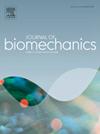Sprint runners have longer Achilles tendon moment arm than distance runners
IF 2.4
3区 医学
Q3 BIOPHYSICS
引用次数: 0
Abstract
The length of the Achilles tendon moment arm may affect muscle shortening velocity, ankle moment, and running economy in running. Regarding the direction of these effects, experimental studies are controversial. These typically use simplified 2-D methods to define the length of the moment arm, and data on high-level athletes are scarce. The purpose of this study was to use a 3-D approach to estimate the length of the Achilles tendon moment arm and examine its association with sprint and endurance running performance in high-level competitive runners.
Twenty-nine healthy adult competitive runners were recruited, including fifteen distance runners (IAAF score = 953 ± 116, mean ± standard deviation) and fourteen sprint runners (IAAF score = 993 ± 113). The length of the Achilles tendon moment arm was estimated from T1 weighted MRI scans taken at a 90° ankle angle.
The sprint runners had longer Achilles tendon moment arms compared to the distance runners when considering absolute lengths (51.8 ± 2.1 mm vs. 48.7 ± 3.8 mm, p = 0.017, Cohen’s d = -0.94), as well as after normalizing to body height (p = 0.004, d = -1.14). However, we did not find any correlation between the absolute or normalized Achilles tendon moment arm length and personal best running performance in either group.
However, longer moment arm may be due to the relatively larger plantar flexor muscle size which can probably offset the detrimental effects of a longer moment arm. On the other hand, distance runners may benefit from a relatively shorter moment arm due to lower forces and increased need for fatigue-resistance. We found no evidence that plantar flexor moment arm is detrimental to running performance in either group, therefore, practitioners should not be concerned about the effects of increasing muscle size on the increase in Achilles tendon moment arm.
求助全文
约1分钟内获得全文
求助全文
来源期刊

Journal of biomechanics
生物-工程:生物医学
CiteScore
5.10
自引率
4.20%
发文量
345
审稿时长
1 months
期刊介绍:
The Journal of Biomechanics publishes reports of original and substantial findings using the principles of mechanics to explore biological problems. Analytical, as well as experimental papers may be submitted, and the journal accepts original articles, surveys and perspective articles (usually by Editorial invitation only), book reviews and letters to the Editor. The criteria for acceptance of manuscripts include excellence, novelty, significance, clarity, conciseness and interest to the readership.
Papers published in the journal may cover a wide range of topics in biomechanics, including, but not limited to:
-Fundamental Topics - Biomechanics of the musculoskeletal, cardiovascular, and respiratory systems, mechanics of hard and soft tissues, biofluid mechanics, mechanics of prostheses and implant-tissue interfaces, mechanics of cells.
-Cardiovascular and Respiratory Biomechanics - Mechanics of blood-flow, air-flow, mechanics of the soft tissues, flow-tissue or flow-prosthesis interactions.
-Cell Biomechanics - Biomechanic analyses of cells, membranes and sub-cellular structures; the relationship of the mechanical environment to cell and tissue response.
-Dental Biomechanics - Design and analysis of dental tissues and prostheses, mechanics of chewing.
-Functional Tissue Engineering - The role of biomechanical factors in engineered tissue replacements and regenerative medicine.
-Injury Biomechanics - Mechanics of impact and trauma, dynamics of man-machine interaction.
-Molecular Biomechanics - Mechanical analyses of biomolecules.
-Orthopedic Biomechanics - Mechanics of fracture and fracture fixation, mechanics of implants and implant fixation, mechanics of bones and joints, wear of natural and artificial joints.
-Rehabilitation Biomechanics - Analyses of gait, mechanics of prosthetics and orthotics.
-Sports Biomechanics - Mechanical analyses of sports performance.
 求助内容:
求助内容: 应助结果提醒方式:
应助结果提醒方式:


